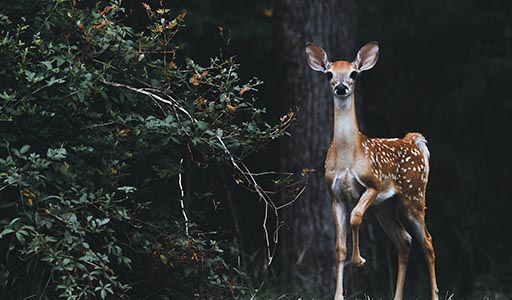Deer

Deer Information
The deer population across many parts of the United States has been growing consistently for decades. Deer are beautiful four-legged creatures that subsist entirely off of plants and vegetation that they pick off of trees and bushes in the wild. Frequently, when deer are fed in residential areas, it increases the likelihood that they will return to these areas in search of food. Entering into residential neighborhoods can result in deer getting hit by cars or trucks. Deer can cause hundreds of dollars worth of damage to your landscaping and plants. And, since they are present in most of the United States, the chances that you have encountered deer on your property is high, especially if you reside in a wooded area.

What does a Deer look like?
White-tailed deer are large, hoofed mammals with reddish-brown or grayish-brown coats, white bellies, and white fur under their short tails. In the springtime, male deer, known as bucks, grow a pair of pointed antlers that are used for defense and mating displays. The animals have long snouts tipped with black noses and large ears that help them stay alert for any signs of predators. Baby deer, known as fawns, are camouflaged with white spots to help them blend into the ground, where they lay motionless until their mothers return given any threat.

What does a Deer eat?
Favorite foods of white-tailed deer include leaves, stems, and buds of trees and saplings. They also readily eat fruits, vegetables, grains, ornamental plants, and nuts. In winter, they eat the bark from trees if other food sources are scarce.

Deer habits
Instead of living in dense thickets, deer prefer the thin edges of forests and young woodlands with easy access to food. Open agricultural areas interspersed with woodlots, as well as wooded suburban areas, also make excellent habitats for deer. In suburban areas where hunting is banned, deer populations can quickly grow to unsustainable numbers. During winter or in adverse weather, deer seek the shelter of dense vegetation.
Problems & Damage
Given large enough populations, deer can destroy garden vegetation with their feeding. Male deer trim their antlers by rubbing them on the trunks of trees, which scratches off the bark and sometimes results in severe and potentially fatal damage. The presence of deer in gardens may also bring ticks to the area, which contributes to the spread of Lyme disease.
Getting Rid of Deer
Homeowners can set up fences as a form of deer deterrent, but this method may not work without the proper materials and placement. The experts at Trutech have the products and training to safely keep deer away from yards.
Frequently Asked Questions
White-tail and mule deer are the most common types of deer found in the U.S. While mule deer typically live in the western portion of the country, white-tail deer are prevalent nationwide. Named for the distinctive white underside of their tails, these pests are normally red- or gray-brown in color with white patches on their stomachs. Conversely, mule deer have black foreheads and narrower tails typically tipped in black. Mule deer get their name from their large and uniquely shaped ears.
Deer and elk are members of the same family and have many things genetically in common. However, there are some areas, such as size and appearance, in which they significantly diverge. Key differences between deer and elk include:
- Mature male elk weigh around 700 pounds, while deer weigh 300 pounds.
- Elk antlers are significantly larger than those of deer, and point upward at a steeper angle.
- Elk can stand five feet tall at the shoulder. Deer typically top out at three and a half feet.
- Elk have a shaggy coat, while deer have a short coat.


